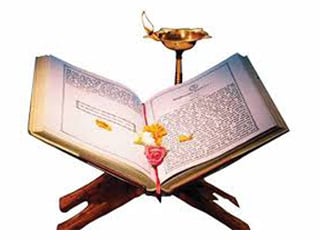
Joining the prana with the apana is pranayama. Then should be practiced pranayama, composed of exhalation (rechaka), retention (kumbhaka), and inhalation (puraka). Lightness of body, clear complexion, good appetite, and hearing of the Nada (Om) are the signs of such purification. This should be practiced for three or four years, or three or four months, according to the direction of a guru, in secret, in the early morning, at midday, in the evening, and at midnight, until the nerves are purified. Again, inhaling through the right nostril, the air should be slowly exhaled through the left nostril in the same way. He should meditate on the mystic syllable Hum at the junction of the right nostril (pingala) and left nostril (ida) and inhale air through the left nostril for twelve seconds (matras) then he should meditate on fire in the same place, repeating the mystic word Rung, and while meditating thus, slowly exhale the air through the right nostril. "Sitting on a soft seat covered first with kusa grass and then with a skin, worshipping Ganesa with fruits and sweetmeats, placing the right palm on the left, holding the neck and the head in the same line, firmly closing the lips, facing the east or the north, fixing the eyes on the tip of the nose, avoiding too much of eating or fasting, the yogi should practice purification of the nadis (nerves), without which the practice of pranayama will be fruitless. "After practising the postures as desired, according to the rules, O Gargi, a man conquers the postures. The following is from the Yajnavalkya Smriti, quoted by Sankaracharya in his commentary: Only the immediate Knowledge of Brahman attained in samadhi can remove the direct and immediate perception of multiplicity. But the knowledge of multiplicity created by ignorance is direct and immediate. Mere intellectual knowledge gives only a mediate or indirect perception of Reality. The teachers of the Upanishads recommend the disciplines of Patanjali's yoga for the attainment of samadhi, in which the Knowledge of Brahman is directly realized. The heart is often described by the yogis as the "abode of Brahman." One feels there most vividly the presence of the Spirit. The wise man should hold his body steady, with the three parts erect, turn his senses, with the help of the mind, toward the heart, and by means of the raft of Brahman cross the fearful torrents of the world. When the seeker knows all these three to be Brahman, he is freed from his fetters. Atman is infinite and all-pervading, and therefore devoid of agency. for there exists further the unborn prakriti, which creates the enjoyer, enjoyment, and the object. The Supreme Lord appears as Isvara, omniscient and omnipotent, and as the jiva, of limited knowledge and power, both unborn.

That non-dual Lord rules over all those causes -time, the self, and the rest. The sages, absorbed in meditation through one-pointedness of mind, discovered the power, belonging to the Lord Himself and hidden in its own gunas. The Bhriguvalli presents the knowledge of the Supreme Self.(A short introduction to the Svetasvatara Upanishad by Shankara) The Practice of Yoga


The BrahmanandaVallienumerates with bliss of the Brahman. ShikshaValli presents instructions for the aspirants and process for attainment of Brahma Jnana or the knowledge of the self. Taittiriya Upanishad is divided into three sections, ShikshaValli, BrahmanandaValli and Bhriguvalli. Theory of Oneness is the ultimate teaching of the Upanishad “ (When) the Soul attains self-sovereignty, becomes lord of the mind, it becomes lord of speech, the lord of the eyes, the lord of the ears, the lord of knowledge then it becomes Brahman its body is the boundless space, its essential nature is the reality, truth its playground the life-force, its consciousness a state of bliss, it exists in serenity, in calmness, in peace, a state of immortality. The seventh, eighth and ninth chapters of the Taittiriya Arantyaka is considered as Taittiriya Upanishad. Taittiriya Upanishad is associated with Taittiriya recension of the Krishna Yajurveda.


 0 kommentar(er)
0 kommentar(er)
